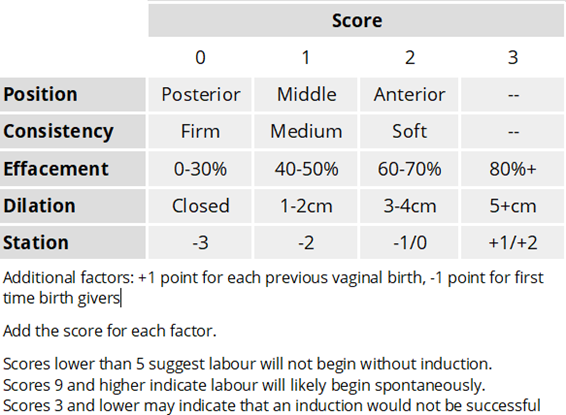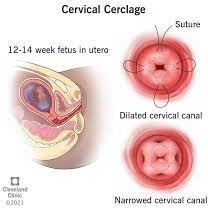Readiness for induction of labor is assessed by determining the:
Apgar score
Bishop score
Biophysical profile
Fetal position
The Correct Answer is B
The readiness for induction of labor is assessed by determining the Bishop score. The Bishop score is a system used to evaluate the cervix for induction of labor readiness. It is based on the assessment of five factors: cervical dilation, cervical effacement, cervical consistency, cervical position, and fetal station. Each factor is scored on a scale of 0 to 3, with a maximum possible score of 15.
The higher the Bishop score, the more favorable the cervix is for induction of labor, and the higher the likelihood of a successful vaginal delivery. A Bishop score of 8 or higher is considered favorable for induction of labor. A low Bishop score may indicate that the cervix is not yet ripe and may need further cervical ripening before induction can be attempted.

The Apgar score is a test used to evaluate a newborn's physical condition at birth, based on five factors: appearance, pulse, grimace, activity, and respiration.
The biophysical profile is a prenatal ultrasound evaluation that assesses fetal well-being by evaluating fetal breathing, fetal movement, fetal tone, amniotic fluid volume, and fetal heart rate. Fetal position is an important consideration during labor, as it can impact the progression and outcome of labor, but it is not used to assess readiness for induction of labor.
Nursing Test Bank
Naxlex Comprehensive Predictor Exams
Related Questions
Correct Answer is D
Explanation
Kangaroo care is skin-to-skin contact between a newborn and parent(s) that helps regulate the infant's temperature, respiratory and heart rates, and enhances parent-infant bonding.
It is recommended for all infants, regardless of their gestational age or health status, and has been found to improve outcomes for premature and low-birth-weight infants. Kangaroo care is not specifically designed to address motor and CNS impairments, nor is it adopted from classical British nursing traditions. While it may help prepare infants for breastfeeding, this is not the primary goal of the intervention.
Correct Answer is B
Explanation
The information that the nurse should emphasize in the discharge teaching for a pregnant woman who has undergone a cervical cerclage due to an incompetent cervix is that the presence of any contractions, rupture of membranes (ROM), or severe perineal pressure should be reported to her healthcare provider immediately. This is because these symptoms could indicate cervical dilation or premature labor, which can lead to pregnancy loss or other complications.
Reporting any vaginal discharge is important, but it is not the most critical symptom to monitor for after cervical cerclage placement. Vaginal discharge is common after cervical cerclage and can occur for several weeks without posing a significant risk to the pregnancy.
A cesarean birth may or may not be necessary depending on the patient's individual circumstances and the course of the pregnancy. It is not a given that all women with cervical cerclage require a cesarean delivery.
While some activity restrictions may be necessary after cervical cerclage placement, it is not necessary for the patient to arrange for care at home. Many women are able to manage their daily activities with appropriate precautions and guidance from their healthcare provider.

Whether you are a student looking to ace your exams or a practicing nurse seeking to enhance your expertise , our nursing education contents will empower you with the confidence and competence to make a difference in the lives of patients and become a respected leader in the healthcare field.
Visit Naxlex, invest in your future and unlock endless possibilities with our unparalleled nursing education contents today
Report Wrong Answer on the Current Question
Do you disagree with the answer? If yes, what is your expected answer? Explain.
Kindly be descriptive with the issue you are facing.
